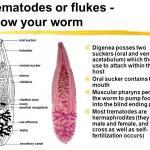
All trematode species that are parasitic for humans are digenetic. Sexual reproduction in the adult fluke is followed by asexual multiplication in the larval stage.

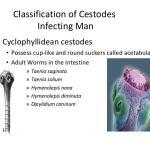
Human infections caused by cestodes, or tapeworms, may occur within the lumen of the bowel, where adult cestodes attach themselves to the host intestine (Box 1). Alternatively, human infection may be the result of dissemination of cestodes from the bowel to involve extraintestinal sites, often by larval forms of the parasite. The life cycle of cestodes is determined by definitive hosts, in whom the mature adult worm lives, and intermediate hosts, which harbor the larval forms of the parasite. Humans are a definitive host for six cestodes: Diphyllobothrium latum, Taenia solium, Taenia saginata, Hymenolepis diminuta, Hymenolepis nana, and Dipylidium caninum.
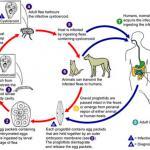
D caninum is distributed worldwide and is associated with wild and domesticated cats and dogs. The life cycle is similar to that of H diminuta, with an obligatory arthropod intermediate host. The adult worm lives in dogs, cats, or humans, and gravid proglottids are released from the adult worm either singly or in short chains.
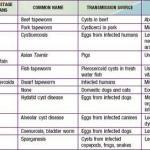
T solium infection occurs worldwide; endemic areas include Mexico, South and Central America, Africa, Southeast Asia, India, and the Philippines. T solium infection is commonly linked to the ingestion of undercooked pork, although other animals may harbor the larval form of the parasite. Infection may be intestinal, which is typically asymptomatic, or extraintestinal (called cysticercosis, see below), which is caused by larval forms of T solium within the tissues of the human host.
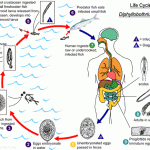
D latum is found worldwide, and infection is acquired by ingestion of contaminated raw or improperly cooked freshwater fish. Because of enthusiasm for raw or undercooked fish, Siberia, Europe, Canada, Alaska, and Japan are endemic regions for D latum infection. Once the D latum cyst has been ingested, the worm matures within the human intestine and begins to produce eggs after 5 weeks.
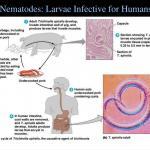
Nematodes (roundworms) are nonsegmented, tapered, bilaterally symmetrical, cylindrical organisms that have complete digestive tracts and reproduce sexually. Although > 500,000 species of nematodes have been described, only a small number are commonly encountered as human parasites. Most nematodes have complex life cycles, sometimes involving several larval forms and intermediate hosts or free-living stages.